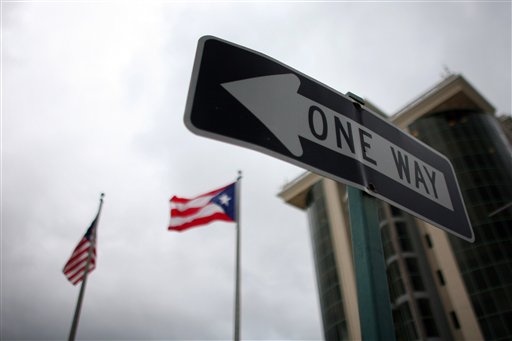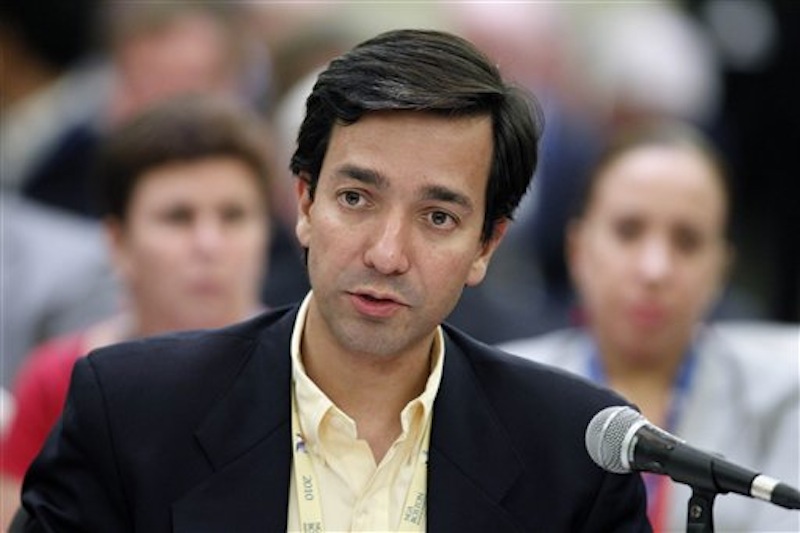SAN JUAN, Puerto Rico — The governor of Puerto Rico is trying to do what more than a century of American citizenship has failed to accomplish: teach Puerto Ricans to speak English as well as they do Spanish.
Gov. Luis Fortuno, who has been mentioned as a possible Republican vice-presidential candidate, has proposed an ambitious, and what critics call far-fetched, plan to require all public schools to teach all courses in English while still offering Spanish grammar and literature classes.
The U.S. territory has had a long and contentious relationship with the English language, and many Puerto Ricans are skeptical about embracing it, fearing they will lose a key part of their identity and find themselves a step closer to statehood, a status that only about half of islanders have backed in recent polls.
The governor wants Puerto Rico to become the 51st U.S. state. But he says his plan is about economic necessity, not politics.
“Bilingualism opens doors and provides opportunity to our children so they can shine and become successful in a labor market that is increasingly competitive and globalized,” he said.
Only 12 of the island’s 1,472 schools offer an all-English curriculum of the sort envisioned by Fortuno, while 35 other schools offer some courses in English, such as math and physical education, said Education Secretary Edwin Moreno.
“The main idea is to have a Puerto Rican who can communicate in Spanish as well as English,” said Moreno, who acknowledged that he himself has an imperfect command of English.
Moreno is overseeing an initial $15 million project to install a bilingual curriculum in 31 schools starting in August and to reinforce the English-Spanish curriculum already in place in the 35 other schools. Plans for adding the rest are still hazy, but the governor says he wants all public school students to be bilingual within 10 years.
Among those rejecting the plan is the Puerto Rico Teachers Association, whose president, Aida Diaz, said that while she supports bilingual education, the notion of teaching all courses in English is extreme.
“This is wrong,” she said. “This leads us to substitute our own language for a secondary one. It should not be that way.”
All public schools are currently required to teach English from kindergarten through high school, and 9,000 teachers are devoted to that, but about 96 percent of the island’s 3.9 million people speak Spanish at home, and some 2.8 million Puerto Ricans do not consider themselves fluent in English, according to the U.S. Census.
That puts Puerto Rican children — and fellow U.S. citizens on the American mainland, as well — behind many Europeans in second-language skills.
According to a 2006 European Community study, 56 percent of Europeans say they can conduct a conversation in more than one language. About 90 percent in the Netherlands and Germany say they can do so. Only about a quarter of mainland Americans can hold a conversation in another language, some studies indicate.
Former Education Secretary Gloria Baquero said the biggest problem in Puerto Rico is the lack of good English teachers.
“Their accent as well as their command of the language is not the best,” she said. “They know the grammar, but the spoken language is not their strong point. So we have a lot of English teachers who end up speaking Spanish in class because the children don’t understand them.”
One solution is to prepare teachers through immersion or exchange programs in the U.S., something that has been done intermittently, she said.
Baquero said she and other educators support Fortuno’s plan but warn it will be hard to implement: “Many people resent the imposition of language and associate any attempt to improve their English with political motives.”
Fortuno’s proposal comes just months before voters face a two-part referendum in November to help decide the island’s political status.
The first part of the referendum will ask if voters want a change in status or prefer to remain a U.S. commonwealth. The second part will ask voters to choose from three options: statehood, independence or something in between called sovereign free association.
GOP presidential candidate Mitt Romney has suggested that English be the official language for all U.S. states but has said there should be no language precondition on Puerto Rican statehood.
English actually dominated Puerto Rican public education during the first half of the 20th century. From 1900 to 1948, all high school subjects were taught in English, until the island’s first democratically elected governor, Luis Munoz Marin, ended the practice.
“The learning of English was associated with a very real thrust by the U.S. government to Americanize Puerto Rico,” said Carlos Chardon, an anthropologist and former education secretary. “A great majority of persons associated English with statehood.”
In 1991, Gov. Rafael Hernandez Colon went further by declaring Spanish the island’s sole official language. The law was repealed a couple of years later by Gov. Pedro Rosello, whose first official act was to make both English and Spanish the official languages, a law that stands to this day, even if only a few places have street signs in English.
Puerto Ricans, however, remain reluctant to learn English, said Jaime Morales, a public school teacher in the northern town of Toa Baja who is fluent in English.
“They are not interested,” he said. “Because honestly, it’s hard to learn the language.”
Morales said he supports the idea of a bilingual curriculum but doubts it will become a reality unless teachers are properly trained, parents get involved and the education system improves.
“The main problem here is that you have a community that does not have good command of Spanish,” he said. “If they are deficient in Spanish, how do you pretend they are going to become fluent in a second language?”
Send questions/comments to the editors.




Success. Please wait for the page to reload. If the page does not reload within 5 seconds, please refresh the page.
Enter your email and password to access comments.
Hi, to comment on stories you must . This profile is in addition to your subscription and website login.
Already have a commenting profile? .
Invalid username/password.
Please check your email to confirm and complete your registration.
Only subscribers are eligible to post comments. Please subscribe or login first for digital access. Here’s why.
Use the form below to reset your password. When you've submitted your account email, we will send an email with a reset code.